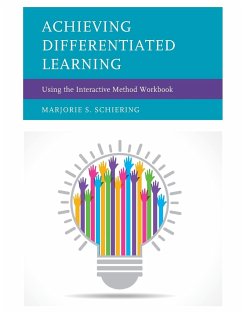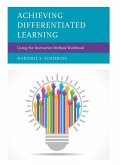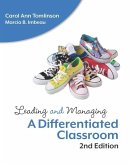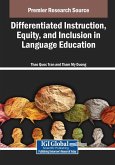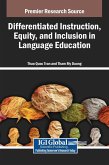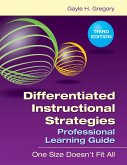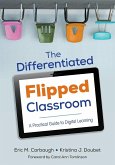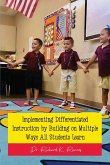- Broschiertes Buch
- Merkliste
- Auf die Merkliste
- Bewerten Bewerten
- Teilen
- Produkt teilen
- Produkterinnerung
- Produkterinnerung
This book is primarily for teachers of student learners with special needs, different abilities or who require a methodology for retention of curriculum and are at any grade, age level.
Andere Kunden interessierten sich auch für
![Achieving Differentiated Learning Achieving Differentiated Learning]() Marjorie S. SchieringAchieving Differentiated Learning85,99 €
Marjorie S. SchieringAchieving Differentiated Learning85,99 €![Leading and Managing a Differentiated Classroom Leading and Managing a Differentiated Classroom]() Carol Ann TomlinsonLeading and Managing a Differentiated Classroom34,99 €
Carol Ann TomlinsonLeading and Managing a Differentiated Classroom34,99 €![Differentiated Instruction, Equity, and Inclusion in Language Education Differentiated Instruction, Equity, and Inclusion in Language Education]() Differentiated Instruction, Equity, and Inclusion in Language Education188,99 €
Differentiated Instruction, Equity, and Inclusion in Language Education188,99 €![Differentiated Instruction, Equity, and Inclusion in Language Education Differentiated Instruction, Equity, and Inclusion in Language Education]() Differentiated Instruction, Equity, and Inclusion in Language Education244,99 €
Differentiated Instruction, Equity, and Inclusion in Language Education244,99 €![Differentiated Instructional Strategies Professional Learning Guide Differentiated Instructional Strategies Professional Learning Guide]() Gayle H. GregoryDifferentiated Instructional Strategies Professional Learning Guide39,99 €
Gayle H. GregoryDifferentiated Instructional Strategies Professional Learning Guide39,99 €![The Differentiated Flipped Classroom The Differentiated Flipped Classroom]() Eric M. CarbaughThe Differentiated Flipped Classroom30,99 €
Eric M. CarbaughThe Differentiated Flipped Classroom30,99 €![Implementing Differentiated Instruction by Building on Multiple Ways All Students Learn Implementing Differentiated Instruction by Building on Multiple Ways All Students Learn]() Richard K. RamosImplementing Differentiated Instruction by Building on Multiple Ways All Students Learn13,99 €
Richard K. RamosImplementing Differentiated Instruction by Building on Multiple Ways All Students Learn13,99 €-
-
-
This book is primarily for teachers of student learners with special needs, different abilities or who require a methodology for retention of curriculum and are at any grade, age level.
Hinweis: Dieser Artikel kann nur an eine deutsche Lieferadresse ausgeliefert werden.
Hinweis: Dieser Artikel kann nur an eine deutsche Lieferadresse ausgeliefert werden.
Produktdetails
- Produktdetails
- Verlag: Rowman & Littlefield Publishers
- Seitenzahl: 124
- Erscheinungstermin: 26. Juli 2019
- Englisch
- Abmessung: 280mm x 216mm x 7mm
- Gewicht: 334g
- ISBN-13: 9781475831740
- ISBN-10: 1475831749
- Artikelnr.: 55480669
- Herstellerkennzeichnung
- Libri GmbH
- Europaallee 1
- 36244 Bad Hersfeld
- gpsr@libri.de
- Verlag: Rowman & Littlefield Publishers
- Seitenzahl: 124
- Erscheinungstermin: 26. Juli 2019
- Englisch
- Abmessung: 280mm x 216mm x 7mm
- Gewicht: 334g
- ISBN-13: 9781475831740
- ISBN-10: 1475831749
- Artikelnr.: 55480669
- Herstellerkennzeichnung
- Libri GmbH
- Europaallee 1
- 36244 Bad Hersfeld
- gpsr@libri.de
Marjorie S. Schiering has devoted her career as an educator to developing teacher's and learner's comprehension of self- efficacy through experiential learning, which focuses on the Interactive Method (IM) and its components. She continually addresses the Cognitive Collective (Reciprocal Thinking and Feelings) to establish and maintain a viable, safe, positive and congenial classroom community where there is teaching of thinking, as well as the concept of our all being teachers of something and that "something" being our character.
Prelude Foreword Preface Acknowledgments Introduction Part One: Explaining
the interactive method (IM) regarding thinking skills, memory, and
classroom implementation Chapter One: Explaining The Interactive Method
(IM): Experience-based Teaching and Learning Chapter Two: Reciprocal
Thinking, Cognitive Collective and Memories The Teaching of Thinking
Chapter Three: Addressing "Different Ways" through Assignments,
Requirements, and Purposes Part two: different learners = different ways:
the "how to" of the "IM" Chapter Four: Six Specific Types of Differention:
Explanation and Example Chapter Five: Different Ways with 25- Examples
Chapter Six: Different Ways with 28-Examples Chapter Seven: Different Ways
with 13- Examples, Including Technology Chapter Eight: Activity-based
Learning Centers/ABLC: 6-Tri-fold Boards Chapter Nine: Graphic
Organizers/Text Structures and Four Interactive Instructional Resources:
Directions and Application Part three: personal commentaries on special
needs and different abilities + author's closing thoughts Chapter Ten:
Personal Perspectives Regarding Parenting and/or Teaching Different
Abilities and Special Needs Students Perspectives on a Learner's Dyslexia:
Patricia Eckardt From the Heart: Having Different Abilities Children: Their
Dad's Narrative: Timothy Ryley Teaching Special Education Technology: Clare
King Chapter Eleven: author's closing thoughts References About the author
the interactive method (IM) regarding thinking skills, memory, and
classroom implementation Chapter One: Explaining The Interactive Method
(IM): Experience-based Teaching and Learning Chapter Two: Reciprocal
Thinking, Cognitive Collective and Memories The Teaching of Thinking
Chapter Three: Addressing "Different Ways" through Assignments,
Requirements, and Purposes Part two: different learners = different ways:
the "how to" of the "IM" Chapter Four: Six Specific Types of Differention:
Explanation and Example Chapter Five: Different Ways with 25- Examples
Chapter Six: Different Ways with 28-Examples Chapter Seven: Different Ways
with 13- Examples, Including Technology Chapter Eight: Activity-based
Learning Centers/ABLC: 6-Tri-fold Boards Chapter Nine: Graphic
Organizers/Text Structures and Four Interactive Instructional Resources:
Directions and Application Part three: personal commentaries on special
needs and different abilities + author's closing thoughts Chapter Ten:
Personal Perspectives Regarding Parenting and/or Teaching Different
Abilities and Special Needs Students Perspectives on a Learner's Dyslexia:
Patricia Eckardt From the Heart: Having Different Abilities Children: Their
Dad's Narrative: Timothy Ryley Teaching Special Education Technology: Clare
King Chapter Eleven: author's closing thoughts References About the author
Prelude Foreword Preface Acknowledgments Introduction Part One: Explaining
the interactive method (IM) regarding thinking skills, memory, and
classroom implementation Chapter One: Explaining The Interactive Method
(IM): Experience-based Teaching and Learning Chapter Two: Reciprocal
Thinking, Cognitive Collective and Memories The Teaching of Thinking
Chapter Three: Addressing "Different Ways" through Assignments,
Requirements, and Purposes Part two: different learners = different ways:
the "how to" of the "IM" Chapter Four: Six Specific Types of Differention:
Explanation and Example Chapter Five: Different Ways with 25- Examples
Chapter Six: Different Ways with 28-Examples Chapter Seven: Different Ways
with 13- Examples, Including Technology Chapter Eight: Activity-based
Learning Centers/ABLC: 6-Tri-fold Boards Chapter Nine: Graphic
Organizers/Text Structures and Four Interactive Instructional Resources:
Directions and Application Part three: personal commentaries on special
needs and different abilities + author's closing thoughts Chapter Ten:
Personal Perspectives Regarding Parenting and/or Teaching Different
Abilities and Special Needs Students Perspectives on a Learner's Dyslexia:
Patricia Eckardt From the Heart: Having Different Abilities Children: Their
Dad's Narrative: Timothy Ryley Teaching Special Education Technology: Clare
King Chapter Eleven: author's closing thoughts References About the author
the interactive method (IM) regarding thinking skills, memory, and
classroom implementation Chapter One: Explaining The Interactive Method
(IM): Experience-based Teaching and Learning Chapter Two: Reciprocal
Thinking, Cognitive Collective and Memories The Teaching of Thinking
Chapter Three: Addressing "Different Ways" through Assignments,
Requirements, and Purposes Part two: different learners = different ways:
the "how to" of the "IM" Chapter Four: Six Specific Types of Differention:
Explanation and Example Chapter Five: Different Ways with 25- Examples
Chapter Six: Different Ways with 28-Examples Chapter Seven: Different Ways
with 13- Examples, Including Technology Chapter Eight: Activity-based
Learning Centers/ABLC: 6-Tri-fold Boards Chapter Nine: Graphic
Organizers/Text Structures and Four Interactive Instructional Resources:
Directions and Application Part three: personal commentaries on special
needs and different abilities + author's closing thoughts Chapter Ten:
Personal Perspectives Regarding Parenting and/or Teaching Different
Abilities and Special Needs Students Perspectives on a Learner's Dyslexia:
Patricia Eckardt From the Heart: Having Different Abilities Children: Their
Dad's Narrative: Timothy Ryley Teaching Special Education Technology: Clare
King Chapter Eleven: author's closing thoughts References About the author

